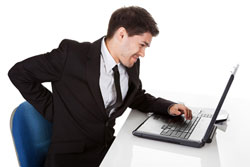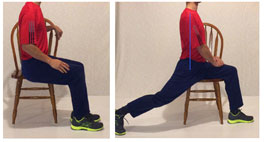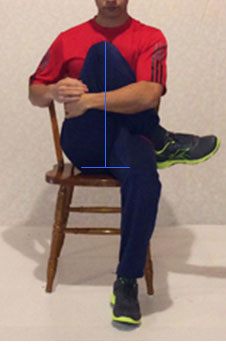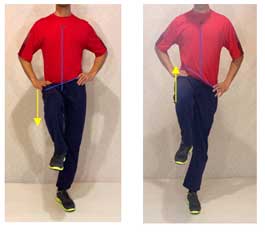Back pain at work? Here is what you should do
By Sherwin Nicholson | May 7, 2020

Take a ‘stretch break’ every 30 min for 1 min to reduce discomfort
It affects us all. No exceptions.
If your back hurts when you sit at your desk, then your job suffers. And you can’t afford time off. If your back ‘goes out’ on you, it may mean missing out on other responsibilities for several days.
We avoid taking time off until the discomfort becomes so unbearable that we can’t move productively. Unfortunately, it sometimes takes a spasm to attack us on the job to stop us.
Watch the warning signs to avoid the spasms
Spasms and stiffness are usually the first warning signs. It could also be a potential disc or nerve injury, or an injury to another muscle. When these areas are at risk, muscles lock up instantly and intensely to protect the body.
Muscles spasms seem to have a mind of their own. We can manage them well, but we are not very good at predicting or controlling them. We are also not very good at knowing when they will fully recover and become frustrated from lost time on the job.
One important sign is when your butt muscles themselves (glutes) hurt.
Don’t Ignore Your Symptoms. It’s Not Worth The Risk.
It’s bad to force yourself through the pain or even speed up the recovery with medication and muscle relaxants. These medications do have their value but are not without complications. If you find yourself treating your lost time this way, then you’re treating the symptoms and not the causes.
The chances are that if you had your injury or spasm at work, you would continue to have it again unless you change what you are doing wrong.
Also, if you have these very uncomfortable episodes outside of your career, then there is also the likelihood that your work habits will worsen them.
Some important practices below can be followed to reduce your chances of injury and spasm while working, thereby making your hours much more productive and pain-free.
Muscles spasms seem to have a mind of their own. We can manage them well, but we are not very good at predicting or controlling them.
Work Place Issues
Note: Follow these 5 important tips to get immediate help and relief if it hurts when you sit at your desk.
If your job requires long hours of sitting, then understand that your spine and the very muscles that are supporting it are NOT stable and active in this position. Whether you are at a computer, bench, table, in a vehicle or any seated position, you’re at risk for injury.
Sitting leads to slouching and poor posture. Very few core muscles if any are actively maintaining a balance posture. Your discomfort slowly builds as a dull ache, then the occasional spasm or tightness, then a full on injury such as a ruptured disc.
Follow these exercises at work for relief:
First, here are the benefits:
- Easy
- Requires little time
- Can be done while sitting
- Can be done in between driving breaks
- Can be done in your spare time
- Helps to correct your bad posture
- Improves the way in which you sit
- Helps both the spine and the hips
- encourages proper muscle reconditioning
- reduces your reliance on medication
- reduces your need for special chairs
- reduces your need for a lumbar brace
This can be done easily while in any seat (and even on the job!). When you begin to sense any dull ache from slouching into a posterior pelvic tilt, you perform the lunge to counter the discomfort . It only takes a few seconds (longer is better) and helps you to continue with your work.
Click HERE or on the Image for a Full Tutorial
It is suggested that you should perform the seated lunge well before you feel that dull ache. You are not just looking for pain management but also for prevention when you sleep. Performing them before your feel sore, allows you to be more proactive.
Do this one also while at the ‘comfort’ of your chair. It is important to stretch out the very area of your body that you have been compressing for hours everyday.
Your glutes were not intended to become your personal seat cushion. They are meant to give you lifting and lowering power, and hip stability. Active glutes always give relief.
Click HERE or on the Image for a Full Tutorial
This exercise not only helps your back, but your hips. A career of sitting is also unsafe for your hips. It is no coincidence that lower back and hip pain are closely linked.
You cannot perform this movement while seated, so you will have to stand up in order to perform it. It is worth the effort. You can actually use the side of your desk or table to help to provide balance. Without performing this exercise, you won’t be able to unlock the tightness connecting your pelvis with the lower back.
Click HERE or on the Image for a Full Description
This exercise will take many days before you will notice any changes in your hip mobility. Don’t quit early. See it through. It is probably one of the most important exercises here. This is not one to skip.
Seated Leg Adjustment (Found in the eBook)
This exercise is necessary to unlock the very stiff and tight hip and pelvic region. This rigid and uncomfortable posture is usually from years of poor posture, spasms and muscle guarding. The use of a book or small block will facilitate this stretch.
It is one of those exercises that require patience and slight discomfort as you are trying to self adjust and mobilize a very tight area that needs to become more flexible. Unlocking this area will give you relief.
In order to benefit from this exercise, please check out the many helpful pages on this site and download the eBook. The full instructions for how to perform this exercise can be found there along with many more. You will be able to find relief and equip yourself with the proper lifelong tools to protect you with your career.
Seated and Floor Leg Hip Shifting (Found in the eBook)
This exercise fully allows mobility to return to your tight hips and pelvis. It restores flexibility to your tight muscles. The different positions and muscles that you will engage for this movement will give you the added strength and technique necessary to prevent this tightness from returning.
Part of this exercise can easily be done while seated at work. This exercise as rarely taught by other professionals and should be as it provides much needed relief.
If you are tired of enduring this form of chronic pain, and are in need of a proven, structured, plan for relief, search this site for more valuable help and Download the eBook to start today.
For More Help:
Ten easy to follow Exercises for Relief
Tips you can easily learn at your job!
When it hurts at work and in the morning
Sleeping Tips that will help you to sleep better
References:
- How to Build Core Stability for Lasting Relief – Gavine & Bonello. 2014. 617.56406Gav. Allen & Unwin Publish.
- Management of chronic lbp .Bogduk N1.-http://www.ncbi.nlm.nih.gov/pubmedhealth/PMH0004665/
- A systematic review of workplace interventions to prevent lbp – Christopher G Maher. The University of Sydney https://doi.org/10.1016/S0004-9514(14)60287-7



